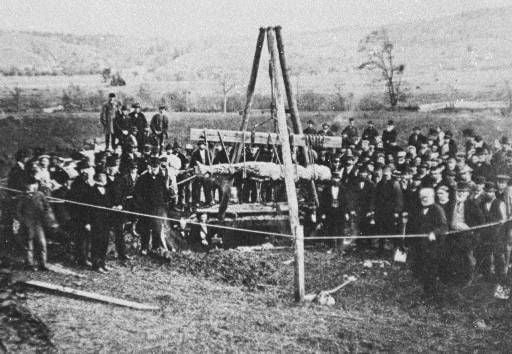The Cardiff Giant Was Just a Big Hoax
Even though it didn’t really look much like a petrified person, spectacle-seekers flocked to view it
/https://tf-cmsv2-smithsonianmag-media.s3.amazonaws.com/filer/87/a2/87a25711-cc26-40ea-b787-c27edc228c4a/cardiff.jpg)
People in the last half of the 1800s liked messing with each other’s heads. It was a weird transitional time to be alive, as the Industrial Revolution changed the world regularly, and there was a great taste for novelty inspired by newly available products and experiences.
Hoaxes flourished. And it was in this “golden age of hoaxes,” writes Mark Rose for Archaeology, that a giant’s body, turned to stone, was discovered in Cardiff, New York–or so it seemed. The Cardiff Giant remains one of nineteenth-century America’s most famous hoaxes, writes scholar Michael Pettit. The story, which began on this day in 1869, was classic fake news–it looked like maybe it could be real, but it was deliberately left open to interpretation.
The giant was found on this day in 1869 by Gideon Emmons and Henry Nichols, two laborers who were digging a well on the Cardiff farm of William Newell. “They hit stone three feet down,” writes Rose. “Clearing the soil, they recognized the shape of a foot.” With some more digging, they unearthed the figure of a ten-foot tall man. Of course, there was absolutely no reason why they should have been digging where they were–except that their boss had told them to. The giant, which many thought was an ancient predecessor of the Onondaga people, had been planted (by Newell) only the year previously.
As news of this discovery spread, Rose writes, hundreds of amature archaeologists and spectacle-seekers headed to the tent Newell had set up over the giant to see what the fuss was about. And even though the giant was clearly a poorly executed statue, people were moved by the possibility that it was real. Pettit writes:
Many spectators understood the giant within the framework of wonder, in which extraordinary objects that seemed to transcend the laws of nature were valued and deemed authentic for precisely that reason. Across the social spectrum–from farmers who paid fifty cents to view the statue where it lay to the transcendentalist philosopher Ralph Waldo Emerson, who viewed the giant at an exhibition in Boston–expressions of wonder were heard.

Viewers were invited to draw their own conclusions about whether the giant was real or faked–and many wanted to believe it was real. That’s at least partially because the existence of the giant seemed to confirm the literal truth of Biblical statements about giants roaming the Earth.
But profit wasn’t the only motive behind the hoax. George Hull, Newell’s cousin and a local tobacco-seller, had crafted the giant to prove a point. Hull was an atheist, a controversial stance for that time in American history, and “though he lacked any formal education, greatly admired science.” He wasn’t wealthy, either, and his plan for the Cardiff giant included both striking it rich and proving a point about the relationship between science and faith.
The giant was sold to a group of businessmen and went on tour. Eventually, its popularity attracted the attention of the age’s greatest huckster, P.T. Barnum. After the businessmen wouldn’t sell him their stony cash cow, Barnum created a replica and began showing it as the real thing. The owners of the authentic “giant” tried to sue Barnum, but according to Rose, the judge hearing the case just said “Bring your giant here, and if he swears to his own genuineness as a bona fide petrification, you shall have the injunction you ask for.” In other words: You can’t really have a fake of a fake. By December of 1869, Moss writes, Hull had confessed to the world that the giant wasn’t real and the hoax was over.
The real question, of course, was why it lasted so long. The Cardiff Giant didn’t even look very real–but people wanted to believe.